Mechanisms of Qing-Gan Li-Shui Formulation in Ameliorating Primary Open Angle Glaucoma: An Analysis Based on Network Pharmacology
- PMID: 35911154
- PMCID: PMC9328959
- DOI: 10.1155/2022/8336131
Mechanisms of Qing-Gan Li-Shui Formulation in Ameliorating Primary Open Angle Glaucoma: An Analysis Based on Network Pharmacology
Abstract
Objective: In this study, we investigated the mechanism of Qing-Gan Li-Shui formulation (QGLSF) in treating primary open glaucoma (POAG) by network pharmacology and in vitro experiments.
Methods: The active pharmaceutical ingredients (APIs) of GLQSF (prepared with Prunella vulgaris, Kudzu root, Plantago asiatica, and Lycium barbarum) were obtained from the Traditional Chinese Medicine Systems Pharmacology Database and Analysis Platform (TCMSP) and Yet Another Traditional Chinese Medicine database (YATCM). The targets of POAG were screened out with GeneCards, OMIM, PharmGKB, Therapeutic Target Database (TTD), and DrugBank databases. The Venny platform was used to summarize the core targets. Topological analysis was performed using Cytoscape3.8.0. A protein-protein interaction network was plotted by STRING online. The key targets were subjected to GO and KEGG enrichment analyses. Finally, the effects of APIs were verified by a model of chloride hexahydrate (CoCl2)-induced retinal ganglion cells-5 (RGC-5).
Results: The main APIs were selected as quercetin (Que) by network pharmacology. Nine clusters of QGLSF targets were obtained by the PPI network analysis, including AKT-1, TP53, and JUN. KEGG enrichment analysis showed that these targets were mainly involved in the AGE-RAGE signaling pathway. By in vitro experiments, Que promoted cell proliferation. The secretion of AKT-1, TP53, JUN, AGE, and RAGE in the cell culture supernatant decreased, as shown by ELISA. The mRNA levels of AKT-1, TP53, JUN, and RAGE decreased, as shown by RT-PCR. QGLSF may employ the AGE-RAGE signaling pathway to counter POAG.
Conclusion: This study preliminarily elucidates the efficacy and mechanism of QGLSF in the treatment of POAG.
Copyright © 2022 Lin Mu et al.
Conflict of interest statement
The authors declare that there are no conflicts of interest.
Figures
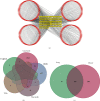
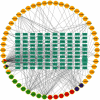

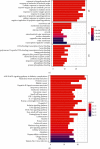
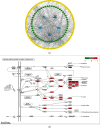
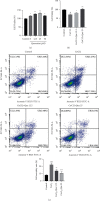


Similar articles
-
Hu-Zhang Qing-Mai Formulation anti-oxidative stress alleviates diabetic retinopathy: Network pharmacology analysis and in vitro experiment.Medicine (Baltimore). 2023 Sep 8;102(36):e35034. doi: 10.1097/MD.0000000000035034. Medicine (Baltimore). 2023. PMID: 37682156 Free PMC article.
-
Study on the Mechanism of Prunella Vulgaris L on Diabetes Mellitus Complicated with Hypertension Based on Network Pharmacology and Molecular Docking Analyses.J Diabetes Res. 2021 Oct 15;2021:9949302. doi: 10.1155/2021/9949302. eCollection 2021. J Diabetes Res. 2021. PMID: 34692849 Free PMC article.
-
Network Pharmacology and Molecular Docking Study on the Potential Mechanism of Yi-Qi-Huo-Xue-Tong-Luo Formula in Treating Diabetic Peripheral Neuropathy.J Diabetes Res. 2021 May 28;2021:9941791. doi: 10.1155/2021/9941791. eCollection 2021. J Diabetes Res. 2021. PMID: 34159207 Free PMC article.
-
Potential Molecular Mechanisms of Ephedra Herb in the Treatment of Nephrotic Syndrome Based on Network Pharmacology and Molecular Docking.Biomed Res Int. 2022 Jul 5;2022:9214589. doi: 10.1155/2022/9214589. eCollection 2022. Biomed Res Int. 2022. PMID: 35837376 Free PMC article.
-
Exploration of the mechanism of Zisheng Shenqi decoction against gout arthritis using network pharmacology.Comput Biol Chem. 2021 Feb;90:107358. doi: 10.1016/j.compbiolchem.2020.107358. Epub 2020 Aug 8. Comput Biol Chem. 2021. PMID: 33243703 Review.
Cited by
-
Hu-Zhang Qing-Mai Formulation anti-oxidative stress alleviates diabetic retinopathy: Network pharmacology analysis and in vitro experiment.Medicine (Baltimore). 2023 Sep 8;102(36):e35034. doi: 10.1097/MD.0000000000035034. Medicine (Baltimore). 2023. PMID: 37682156 Free PMC article.
-
A Case Study from the Past: "The RGC-5 vs. the 661W Cell Line: Similarities, Differences and Contradictions-Are They Really the Same?".Int J Mol Sci. 2023 Sep 7;24(18):13801. doi: 10.3390/ijms241813801. Int J Mol Sci. 2023. PMID: 37762103 Free PMC article.
References
LinkOut - more resources
Full Text Sources
Research Materials
Miscellaneous

